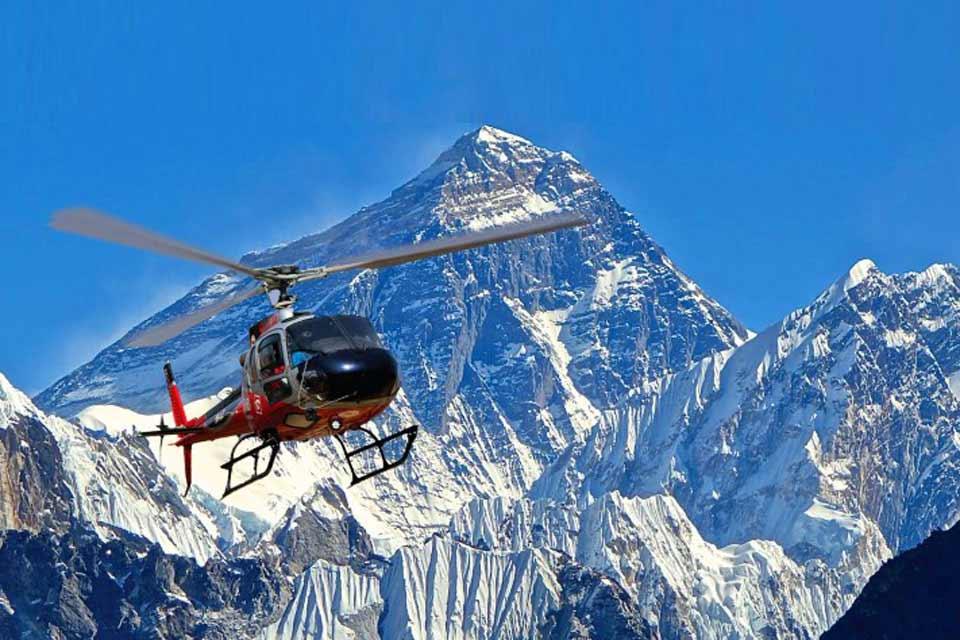Does a helicopter land at Everest Base Camp? Here's what you need to know.
Helicopters are a popular mode of transportation to Everest Base Camp, but can they actually land there? Find out everything you need to know in this article.
Helicopters have become a common sight at Everest Base Camp, providing a faster and more convenient way for climbers and trekkers to reach the base of the world's highest mountain. But can these aircraft actually land at the campsite, which sits at an altitude of over 17,000 feet? In this article, we'll explore the logistics of helicopter landings at Everest Base Camp and what you need to know if you're planning a trip to the Everest Region.
If you are interested in helicopter transportation to Everest Base Camp, there are several companies that offer this service. However, it is important to note that the cost of helicopter transportation is significantly higher than trekking to Base Camp by foot and may not be covered by your travel insurance.
Helicopter transportation to Everest Base Camp.
Helicopters have become a popular mode of transportation for climbers and trekkers to reach Everest Base Camp. However, due to the high altitude and challenging terrain, landing a helicopter at the campsite can be difficult. In fact, only certain types of helicopters are capable of landing at the camp, and even then, it's not always possible due to weather conditions and other factors. If you're planning a trip to Everest Base Camp via Helicopter, it's important to do your research and work with a reputable tour operator to ensure a safe and successful journey.
Additionally, helicopter flights to Everest Base Camp are subject to weather conditions, and flights may be cancelled or delayed if conditions are not favorable. It is important to plan for potential delays or cancellations and to have a contingency plan in place.
If you are considering helicopter transportation to Everest Base Camp, it is recommended that you consult with Trekking Planner Nepal, who can provide you with more information and help you plan your trip.
Landing restrictions and challenges at Everest Base Camp while Taking a Helicopter Tour.
Landing a helicopter at Everest Base Camp is no easy feat. The high altitude, unpredictable weather conditions, and challenging terrain make it a difficult task. In fact, only certain types of helicopters are capable of landing at the campsite, such as the Eurocopter AS350 B3 and the Bell 407. Even with these specialized helicopters, landings are not always possible due to weather conditions or other factors. Additionally, there are strict landing restrictions in place to protect the fragile environment and ensure the safety of climbers and trekkers. It's important to work with a reputable tour operator who has experience navigating these challenges and can ensure a safe and successful journey.

One of the biggest challenges to landing at Everest Base Camp is the altitude. The camp is located at an elevation of approximately 5,364 meters (17,598 feet), which can make it difficult for helicopters to operate safely and efficiently. The thin air at this altitude can affect the helicopter's performance, making it harder to take off and land.
In addition to the altitude, the weather conditions at Everest can be unpredictable and change rapidly. High winds, low visibility, and sudden storms can make it difficult or impossible for helicopters to land or take off safely. This can result in flight delays or cancellations, or, in extreme cases, emergency situations.
Another challenge of landing at Everest Base Camp is the limited space for helicopter operations. The camp is located on a glacier, which means that there is limited flat, stable ground for helicopters to land on. This can make it difficult for pilots to find a suitable landing spot and increase the risk of accidents or damage to the helicopter.
To address these challenges, helicopter operators who offer tours to Everest Base Camp typically work closely with experienced pilots and ground crews who are familiar with the terrain and weather conditions. They may also use specialized equipment, such as high-altitude helicopters, to improve safety and performance.
Despite these challenges, helicopter tours to Everest Base Camp can be a once-in-a-lifetime experience for those who want to see the world's highest mountain up close. It is important, however, to choose a reputable operator and to plan for potential delays or cancellations due to weather or other factors.
Alternatives for landing rather than landing at Everest Base Camp.
While landing at Everest Base Camp via Helicopter is a popular option for many trekkers and climbers, it's not the only way to reach the site. Some tour operators offer alternative options, such as landing at a nearby helipad and trekking to Base Camp or taking a scenic flight over the Himalayas without landing. These alternatives can still provide stunning views and a unique experience without the added risks and challenges of landing at the campsite. It's important to discuss all options with your tour operator and choose the best option for your individual needs and preferences.
There are several alternative helicopter landing sites in the Everest Region that offer stunning views of the Himalayas and access to the local culture. Here are some options:
- Kala Patthar: This is a popular destination for trekkers and climbers as it offers stunning views of Everest, Lhotse, Nuptse, and other peaks in the region. It is located at an elevation of 5,545 meters and is a great alternative for those who want to experience the thrill of being close to the highest peak in the world.
- Gokyo Lakes: The Gokyo Lake are a series of turquoise-blue lakes located in the Sagarmatha National Park. The lakes are surrounded by snow-capped peaks and offer stunning views of the Himalayas. This is a great alternative for those who want to experience the natural beauty of the region without the crowds at Everest Base Camp.
- Namche Bazaar: This is a bustling town located in the heart of the Khumbu Region. It is a great place to experience the local culture and shop for souvenirs. The town is surrounded by stunning peaks and is a great alternative landing site for those who want to explore the region.
- Tengboche Monastery: This is one of the most famous monasteries in the Everest Region and is located at an elevation of 3,867 meters. The monastery offers stunning views of Everest and other peaks in the region. It is a great alternative landing site for those who want to experience the spiritual side of the region.
- Ama Dablam Base Camp:Ama Dablam is one of the most beautiful peaks in the region, and its base camp offers stunning views of the mountain. The base camp is located at an elevation of 4,600 meters and is a great alternative landing site for those who want to experience the beauty of the region without the crowds of Everest Base Camp.
These are just a few of the many helicopter landing options available in the Everest Region, and each one offers a unique experience.

Safety considerations for helicopter flights.
When considering a helicopter flight to Everest Base Camp, safety should be a top priority. It's important to choose a reputable tour operator with experienced pilots and well-maintained helicopters. Weather conditions can also impact the safety of the flight, so it's important to check the forecast and be prepared for potential delays or cancellations. Additionally, passengers should follow all safety instructions provided by the pilot and wear appropriate gear, such as a helmet and seatbelt. By prioritizing safety, you can enjoy a memorable and safe experience at Everest Base Camp.
Safety is a top priority for helicopter flights in the Everest Base Camp Region. Here are some important safety considerations to keep in mind:
- Weather: The weather in the Everest Region can be unpredictable and can change rapidly. It is important to keep an eye on the weather forecast and be prepared for changes in weather conditions. Helicopter flights may be delayed or canceled due to bad weather, so it is important to have a backup plan.
- Altitude sickness: The Everest Region is at high altitude, and altitude sickness can be a serious concern for those who are not acclimatized. It is important to take the necessary precautions and to listen to the advice of the helicopter pilot and medical professionals.
- Helicopter maintenance: It is important to ensure that the helicopter being used is well maintained and in good working condition. The helicopter should be inspected before each flight, and any issues should be addressed immediately.
- Pilot experience: The pilot's experience and qualifications are critical to the safety of the flight. Make sure that the pilot has experience flying in the Everest Region and is familiar with the local weather patterns and terrain.
- Emergency procedures: It is important to be familiar with the emergency procedures in case of an emergency. The helicopter should be equipped with the necessary safety equipment, including oxygen and a first aid kit.
- Weight restrictions: Helicopters have weight restrictions, and it is important to ensure that the weight limit is not exceeded. This is especially important in the Everest region, where the high altitude can affect the performance of the helicopter.
By keeping these safety considerations in mind, you can help ensure a safe and enjoyable helicopter flight in the Everest Base Camp region.

Planning your Everest Base Camp trip with helicopter transportation.
Helicopter Transportation is a popular option for those planning a trip to Everest Base Camp. However, it's important to do your research and choose a reputable tour operator with experienced pilots and well-maintained helicopters. It's also important to consider weather conditions and potential delays or cancellations. By prioritizing safety and following all instructions provided by the pilot, you can have a safe and enjoyable experience at Everest Base Camp.
If you are planning a trip to Everest Base Camp with helicopter transportation, here are some steps to follow:
- Choose your helicopter service:Trekking planner Nepal researches and compares different helicopter services that offer flights to the Everest Base Camp Region. A reputable company with experienced pilots and well-maintained helicopters.
- Plan Your Itinerary: Decide how many days you want to spend in the Everest Region and what activities you want to do. Keep in mind that altitude sickness can be a concern, so it is important to schedule in rest days to acclimatize.
- Choose your Landing Site: Decide where you want to land your helicopter. Everest Base Camp is a popular option, but there are also other landing sites in the region that offer stunning views and cultural experiences.
- Pack appropriately: Make sure to pack warm clothing, sturdy hiking boots, and other necessary gear for trekking in a high-altitude environment. You may also want to bring a camera to capture the stunning views.
- Consider hiring a guide: Hiring a local guide can be helpful for navigating the trekking routes and learning about the local culture. Guides can also help with acclimatization and emergency situations.
- Be prepared for emergencies : Make sure to have a first aid kit, emergency supplies, and a plan for emergency evacuation in case of injury or illness.
Follow safety guidelines and listen to the advice of your helicopter pilot and guide. Be aware of the risks of altitude sickness and take the necessary precautions.
By following these steps, you can plan a safe and enjoyable trip to Everest Base Camp with helicopter transportation.





